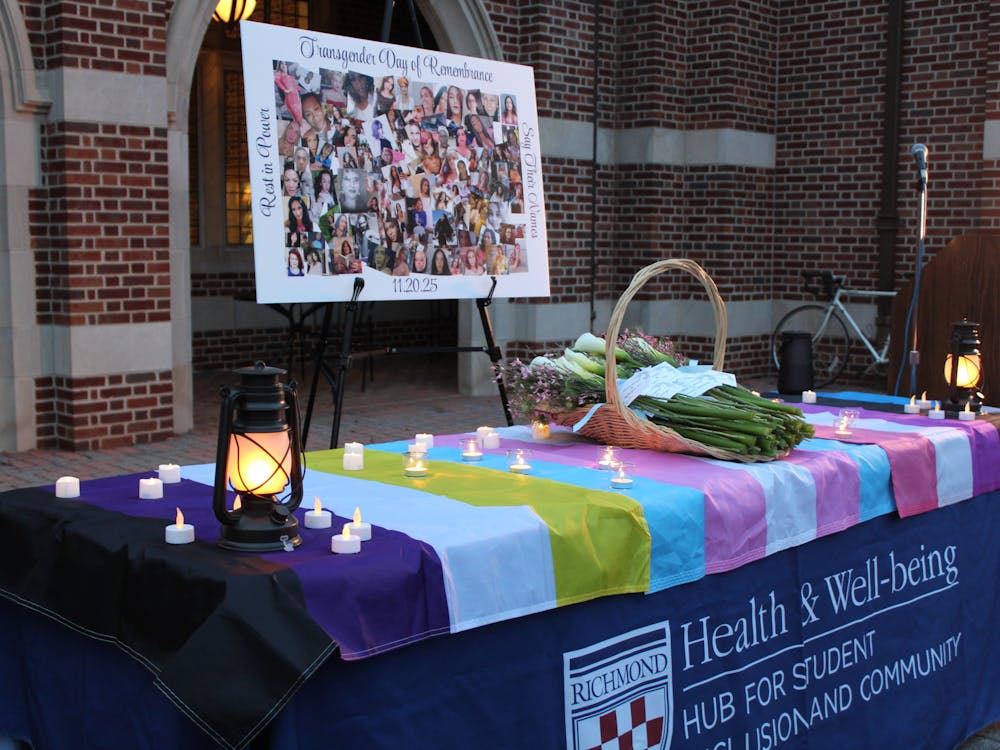The publication of the first issue of a new University of Richmond conservative opinion journal, The Richmond Review, is scheduled for Nov. 5.
Sophomores Timothy Patterson and Dan Rudary, who were looking for an outlet to voice their conservative opinions, founded the new publication.
Although neither Patterson, the senior editor, nor Rudary, the associate editor, plan to major in journalism, both have a serious interest in opinion writing and have some background in journalism.
"I did some writing in high school, and I was looking to get involved here," Patterson said. "So I did some research into conservative publications at other schools."
Rudary was the editor of his high school newspaper and was also looking for a channel for conservative journalism.
Both Patterson and Rudary are active members of the College Republicans. While brainstorming plans for the College Republicans during the summer, they discussed the possibility of founding a conservative opinion journal, Rudary said. But the publication is not affiliated with the College Republicans.
The editorial staff of The Richmond Review said that the publication was not founded as a criticism of The Collegian.
"It's just a different kind of publication dedicated to a certain philosophy," Patterson said. "It's not meant to be the anti-Collegian." He elaborated that this is a philosophy of promoting traditional fiscal and social conservative values, ranging from limited regulation of industry to pro-life issues.
"It's purpose will be completely separate from The Collegian," Patterson said. "We will be taking the news but looking at it through a lens of traditional conservative values."
Rudary also made it clear that The Richmond Review is not meant to be a competitor with The Collegian.
But the brochure outlining the general purpose of the new publication states: "For decades, student publications at American colleges and universities have been platforms for the left" and "conservative students had little or no voice for their political, social, and religious viewpoints." The Review aims to give these students a voice.
"We want this to be a forum for students to voice a conservative opinion," Patterson said, "but that statement was not a reference to The Collegian. Someone could probably argue that The Collegian is a leftist organization, but that is not an assertion I am making. That statement was meant to paint with a much broader brush. There are a lot more liberal examples of college newspapers."
Enjoy what you're reading?
Signup for our newsletter
The production costs of the first issue of The Richmond Review were covered by a $750 grant from the Leadership Institute. According to Patterson, the Leadership Institute is a non-profit, non-partisan organization that helps promote traditional conservative values on college campuses.
Michelle Miller, director of communications at the Leadership Institute, explained that they have "ample evidence that the majority of official campus newspapers are left-wing." She was unwilling to comment on The Collegian specifically.
The Leadership Institute's funds come from thousands of individual donors from across the country. The foundation identifies and recruits conservative students on college campuses across the county and helps them organize independent conservative groups and publications.
Miller explained that in the case of Richmond, conservative students identified a need for a conservative publication on campus and came to the Leadership Institute for training and financial support.
"We hope they will promote conservative principles of limited government, free enterprise, strong national defense and traditional moral values," Miller said.
The Richmond students received a Balance in Media Grant from the Institute to fund the first issue. According to Patterson, the institute is also assisting them to establish the infrastructure for an effective direct-mail campaign to fund future issues.
"They are connecting us with a network of generous donors who wish to encourage intellectual diversity on college campuses and see our publication as a means to combat excessive liberalism," Patterson said.
The students met with a field representative from the Leadership Institute and then a student publications coordinator who instructed them on writing, fundraising and design layout.
According to Miller, the Leadership Institute sent out 60 field representatives last year and increased the number of independent, conservative student groups on college campuses to 1,004.
The Richmond Review is designed to be an opinion journal rather than a newspaper, similar to independent publications at other colleges and Universities, such as The Cornell Review, The Dartmouth Review and The Harvard Salient. These publications, like The Richmond Review, bill themselves as the "conservative voice" of their respective colleges.
These publications have been tough and aggressive, often provoking controversy on their campuses and attracting national media attention.
On Nov. 28, 2006, the cover of The Dartmouth Review had an image of an Indian holding a scalp with the headline "The Natives are Getting Restless." The image was associated with anti-Indian rhetoric and stirred controversy on the campus, and its publication was followed by a student-organized "Solidarity Against Hatred Rally."
In the Dec. 6, 2006, issue the editorial staff published a retraction, stating: "The recent Dartmouth Review cover depicting a warrior with a scalp was a mistake. It distracted attention from the serious journalism The Dartmouth Review has been publishing, not least in the articles that came after the cover."
The Cornell Review has also sparked student protest and attracted national media attention. In 1997, The Cornell Review published an anonymous editorial that was a parody of Ebonics and Africana Studies, using offensive, stereotyped African-American language. Student protesters publicly burned hundreds of copies of the publication. The editorial staff defended the publication of the editorial as its first amendment right.
The following year, The Cornell Review published a cartoon titled "Which One of these Kills More Blacks?" The cartoon had three panels depicting the Ku Klux Klan, a Nazi group and an abortion doctor. The publication of this cartoon sparked another campus-wide protest, where hundreds of copies of The Cornell Review were again publicly burned.
The brochure for The Richmond Review contains an image of the public burning of the Cornell publication with the caption "as a member of the Richmond Review, you can help spark meaningful debate on campus!"
According to Patterson, the editorial staff of The Richmond Review has looked to these publications for ideas and modeled the new publication after them. Patterson has been in contact with the editor of The Dartmouth Review and has conducted research into conservative publications at other schools.
When comparing the new Richmond publication to these established publications, Rudary explained that "they aren't really newspapers, but conservative journals for intellectual discussion and debate."
According to the editorial staff, The Richmond Review will focus primarily on analyzing news events but will also focus on politics, social issues, economics and other issues on campus. The brochure states that The Richmond Review will feature "sound, meaningful, and insightful articles written on top conservative issues of the day."
Work on the first issue has already begun, and Patterson and Rudary have recruited a staff of five conservative writers. They set up a table at the Student Organization Fair to let freshmen know about the new publication and the writing opportunities.
"We are going to start small, but we want to expand," Rudary said. "We are looking for anyone who is interested in writing, layout or fundraising." Rudary added that currently none of the staff are paid, but in the future they hope to have a stipend for their staff writers.
Support independent student media
You can make a tax-deductible donation by clicking the button below, which takes you to our secure PayPal account. The page is set up to receive contributions in whatever amount you designate. We look forward to using the money we raise to further our mission of providing honest and accurate information to students, faculty, staff, alumni and others in the general public.
Donate Now


